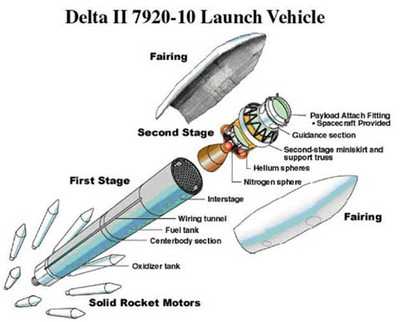Mission: To Better Understand the Air We Breathe
Aura, a mission dedicated to the health of Earth's atmosphere,
successfully launched today at 0301:59 Pacific Time from the
Western Range of Vandenberg Air Force Base (CA) aboard a Boeing
Delta II rocket. Spacecraft separation occurred at 4:06 a.m.
Pacific Time, inserting Aura into a 705-kilometer (438-mile)
orbit.

NASA's latest Earth-observing satellite, Aura will help us
understand and protect the air we breathe.
"This moment marks a tremendous achievement for the NASA family
and our international partners," said NASA Associate Administrator
for Earth Science Dr. Ghassem Asrar. "We look forward to the Aura
satellite offering us historic insight into the tough issues of
global air quality, ozone recovery and climate change.
"This mission advances NASA's exploration of Earth and will also
better our understanding of our neighbors in the planetary system,"
he added. "Aura joins its siblings, Terra, Aqua and 10 more
research satellites developed and launched by NASA during the past
decade, to study our home planet, Earth."
"Many people have worked very hard to reach this point and the
entire team is very excited," said Aura Project Manager Rick
Pickering of NASA's Goddard Space Flight Center, Greenbelt
(MD).
With the launch of Aura, the first series of NASA's Earth
Observing System satellites is complete. The other satellites are
Terra, which monitors land, and Aqua, which observes Earth's water
cycle.
Aura will help answer three key scientific questions: Is the
Earth's protective ozone layer recovering? What are the processes
controlling air quality? How is the Earth's climate changing? NASA
expects early scientific data from Aura within 30-90 days.
Aura will also help scientists understand how the composition of
the atmosphere affects and responds to Earth's changing climate.
The results from this mission will help scientists better
understand the processes that connect local and global air
quality.
Each of Aura's four instruments is designed to survey different
aspects of Earth's atmosphere. Aura will survey the atmosphere from
the troposphere, where mankind lives, through the stratosphere,
where the ozone layer resides and protects life on Earth.

Aura's four instruments are: the High Resolution Dynamics Limb
Sounder (HIRDLS); the Microwave Limb Sounder (MLS); the Ozone
Monitoring Instrument (OMI); and the Tropospheric Emission
Spectrometer (TES). NASA's Jet Propulsion Laboratory, Pasadena
(CA), developed and manages MLS and TES. HIRDLS was built by the
United Kingdom and the United States. OMI was built by the
Netherlands and Finland in collaboration with NASA. NASA's Goddard
Space Flight Center manages the Aura mission.
The Microwave Limb Sounder is intended to improve our
understanding of ozone in Earth's stratosphere, which is vital in
protecting us from solar ultraviolet radiation. The Tropospheric
Emission Spectrometer is an infrared sensor designed to study
Earth's troposphere and to look at ozone and other urban
pollutants.
NASA's Earth Science Enterprise is dedicated to understanding
the Earth as an integrated system and applying Earth System Science
to improve prediction of climate, weather and natural hazards using
the unique vantage point of space.
 ANN's Daily Aero-Linx (04.15.24)
ANN's Daily Aero-Linx (04.15.24) Classic Aero-TV: 'No Other Options' -- The Israeli Air Force's Danny Shapira
Classic Aero-TV: 'No Other Options' -- The Israeli Air Force's Danny Shapira Aero-News: Quote of the Day (04.15.24)
Aero-News: Quote of the Day (04.15.24) Airborne 04.16.24: RV Update, Affordable Flying Expo, Diamond Lil
Airborne 04.16.24: RV Update, Affordable Flying Expo, Diamond Lil ANN's Daily Aero-Term (04.16.24): Chart Supplement US
ANN's Daily Aero-Term (04.16.24): Chart Supplement US




